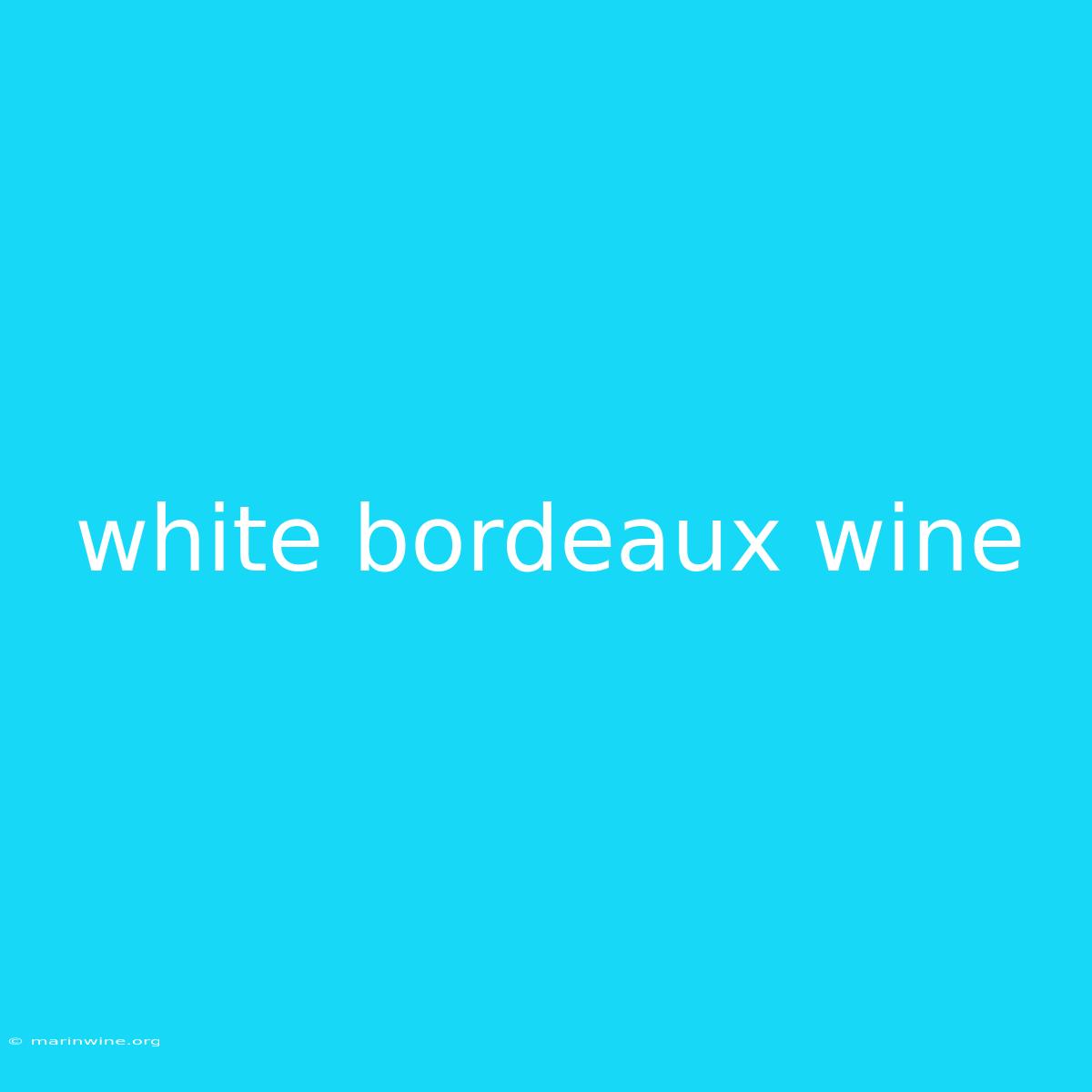Unlocking the Secrets of White Bordeaux: A Journey Through Elegance and Complexity
Have you ever wondered why white Bordeaux wines often remain overshadowed by their red counterparts? The truth is, these elegant and complex wines offer a unique and rewarding experience, deserving of a closer look.
Why White Bordeaux Matters
White Bordeaux holds a special place in the world of wine. This region, renowned for its rich red wines, also produces exceptional whites with vibrant acidity, layered aromas, and impressive aging potential. The use of diverse grape varieties like Sauvignon Blanc, Sémillon, and Muscadelle creates an intriguing spectrum of flavors and styles, ranging from crisp and refreshing to opulent and complex.
Key Takeaways of White Bordeaux:
| Key Feature | Description |
|---|---|
| Grape Varieties | Dominated by Sauvignon Blanc, Sémillon, and Muscadelle, often blended for complexity. |
| Terroir | Diverse soils ranging from gravel to clay contribute to the wines' distinct character. |
| Style | From dry and crisp to rich and complex, offering a wide range of styles. |
| Aging Potential | Many white Bordeaux wines are capable of aging gracefully for years, developing complex aromas and flavors. |
| Food Pairing | Versatile pairings, from seafood and shellfish to poultry and even spicy dishes. |
Uncovering the World of White Bordeaux
1. Sauvignon Blanc: The Backbone of Freshness:
This grape variety is the dominant force in white Bordeaux, bringing a lively acidity, vibrant fruit flavors, and a touch of herbaceousness. Its influence is readily apparent in wines like those from the Entre-Deux-Mers region, known for their crispness and refreshing character.
2. Sémillon: The Master of Complexity:
Sémillon offers a counterpoint to Sauvignon Blanc's zesty nature, contributing rich texture, opulent aromas of honey and citrus, and a remarkable aging potential. Its presence is particularly evident in wines from the Sauternes region, renowned for their sweet and luscious dessert wines.
3. Muscadelle: The Aromatic Enhancer:
Muscadelle, while less prevalent, adds a floral dimension and distinctive notes of orange blossom and beeswax. Its inclusion in blends enhances complexity and brings a touch of delicate sweetness.
4. The Influence of Terroir:
The diverse terroir of Bordeaux plays a significant role in the character of white wines. The Graves region, for instance, produces wines with greater minerality and body due to the presence of gravelly soils. Meanwhile, the Entre-Deux-Mers wines exhibit more fruit-forwardness due to the influence of clay soils.
A Deeper Dive into White Bordeaux
Understanding the Blends:
Bordeaux's white wines are often blends, harnessing the unique qualities of each grape variety. A classic blend might feature Sauvignon Blanc for crispness, Sémillon for richness, and Muscadelle for floral notes. This interplay of flavors creates a complex and harmonious wine.
Exploring the Aging Potential:
Many white Bordeaux wines, particularly those with a higher proportion of Sémillon, are capable of aging beautifully for several years. As they mature, they develop complex aromas of toast, honey, and dried fruits, adding another dimension to their character.
Pairing White Bordeaux:
White Bordeaux wines are incredibly versatile, pairing well with a wide range of dishes. Their refreshing acidity and diverse flavor profiles complement seafood, shellfish, poultry, and even spicy Asian cuisine.
FAQ for White Bordeaux
1. Are all white Bordeaux wines sweet?
No, while Sauternes is famous for its sweet wines, most white Bordeaux wines are dry. They offer a spectrum of styles from crisp and refreshing to rich and complex.
2. How long do white Bordeaux wines age?
The aging potential depends on the blend and style. Some wines are best enjoyed young, while others can age for several years, developing complex flavors.
3. Where can I find white Bordeaux wines?
White Bordeaux wines are available in many wine shops and restaurants. Explore online retailers or contact local wine merchants for more specific recommendations.
4. What is the best way to serve white Bordeaux?
Serve white Bordeaux chilled, ideally between 45-50 degrees Fahrenheit (7-10 degrees Celsius) to enhance its flavors.
5. Are there any specific recommendations for white Bordeaux wines?
Consider exploring wines from the Graves region, known for their rich and complex character, or the Entre-Deux-Mers, renowned for their crisp and refreshing style.
6. Are there any specific food pairings I should try?
Experiment with pairing white Bordeaux with seafood, shellfish, poultry, or even spicy Asian cuisine. The lively acidity and diverse flavors of these wines complement a wide range of dishes.
Tips for Enjoying White Bordeaux
-
Choose the Right Bottle: Opt for a wine with a high proportion of Sauvignon Blanc for a crisp and refreshing style, or one with a greater percentage of Sémillon for a richer and more complex experience.
-
Serve it Chilled: Enjoy the full spectrum of flavors by chilling your white Bordeaux before serving.
-
Explore the Blends: Experiment with different blends to discover the unique qualities of each grape variety and their interplay.
-
Pair with Food: Explore the versatility of white Bordeaux by pairing it with a range of dishes, from seafood to poultry and even spicy Asian cuisine.
-
Seek Expert Advice: Consult with a local wine merchant or sommelier for personalized recommendations tailored to your preferences.
Summary of White Bordeaux
White Bordeaux wines offer a captivating journey through elegance and complexity. From the refreshing crispness of Sauvignon Blanc to the opulent richness of Sémillon, this region presents a diverse and rewarding experience for any wine enthusiast. With their versatility in food pairings and impressive aging potential, white Bordeaux wines deserve a place in any wine lover's repertoire.
Closing Message: Don't be afraid to explore the world of white Bordeaux. It offers a captivating journey through elegance and complexity, challenging preconceptions and rewarding your palate with a unique and fulfilling experience.

